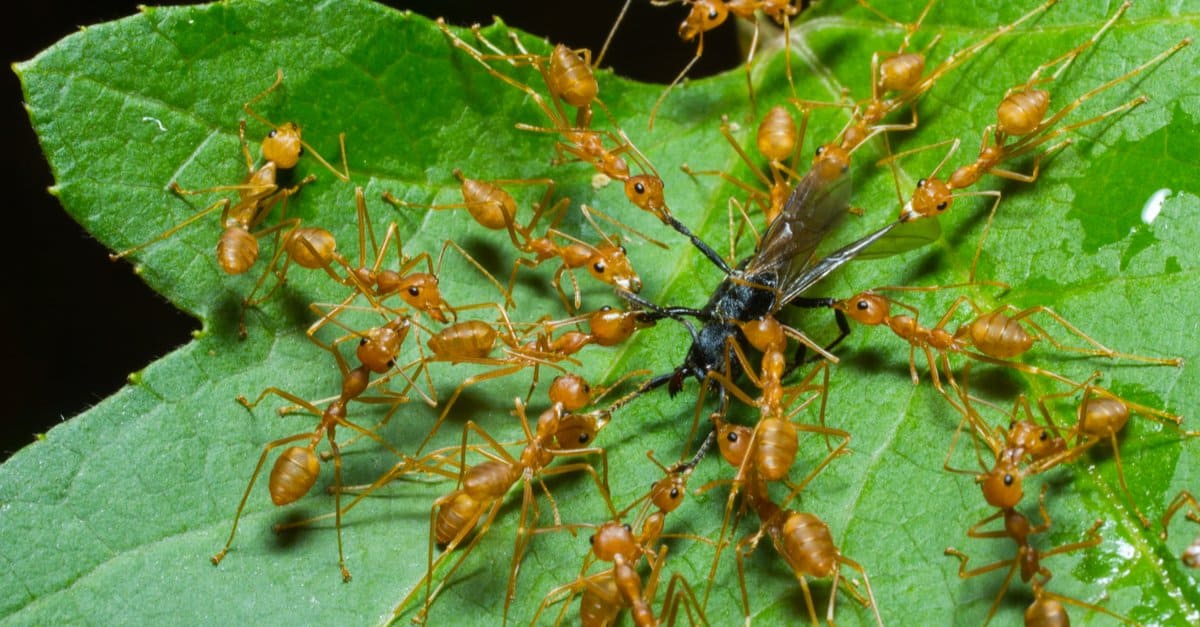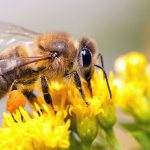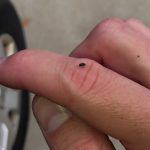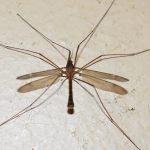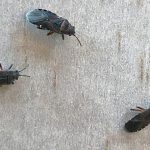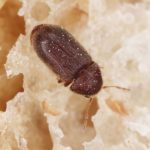Ants are truly remarkable creatures, with their highly organized and efficient societies and incredible diversity. They can be found in almost every corner of the world, from deserts to rainforests, thriving on various diets.
But have you ever wondered what ants eat? Contrary to popular belief, these tiny insects are not just sugar-loving pests.
Ants are omnivores, meaning they feed on both plant and animal matter. Some species of ants are herbivores, munching on leaves and flowers for sustenance.
Others are carnivores, hunting down prey like insects, spiders, and other small creatures. And then there are the scavengers who feed on dead and decaying organic matter such as dead insects or animals, fungi, and even excrement.
The diet of an ant colony is constantly changing throughout the year based on the availability of different food sources.
When food is plentiful in spring and summer, ants will focus on storing food for the winter when resources become scarce. This is when you’ll often see them carrying large pieces of food back to their colony.
In this blog post, we will take a closer look at the types of foods ants eat and how their diet affects their behavior and survival as a colony.
Whether you’re curious about these fascinating insects or an aspiring entomologist looking to learn more about ant ecology – this post has got you covered.
So, let’s dive into the captivating world of ants together and uncover what fuels these tiny powerhouses.
Ants’ Diet
Contents
- 1 Ants’ Diet
- 2 Types of Foods That Ants Eat
- 3 Sweet Foods
- 4 Protein-rich Foods
- 5 Specialized Diets
- 6 Scavenging for Food
- 7 Predatory Nature of Some Ant Species
- 8 Determining the Diet of an Ant Colony
- 9 The Queen’s Specialized Diet for Egg Production
- 10 Nutritional Benefits of Eating a Variety of Foods
- 11 Potential Health Risks Associated with Eating Garbage or Dead Animals
- 12 Ways to Deter Ants from Entering Your Home or Garden
- 13 Conclusion
Ants are remarkable creatures with a fascinating diet that enables them to survive in various environments. As omnivores, ants have a diverse diet of plants and animals, and their dietary habits can vary depending on the species and location.
Herbivorous ants, for instance, have a sweet tooth and feed mainly on nectar, pollen, and other sugary substances from flowers or plant sap. They also collect seeds and fruits for storage in their colonies. Interestingly, some ants have a symbiotic relationship with plants where they protect the plant in exchange for food.
Carnivorous ants, on the other hand, are skilled hunters who capture and kill other insects or small animals for food. These ants have strong mandibles that allow them to carry prey back to their colonies. Their hunting efficiency is impressive.
Scavenger ants are opportunistic feeders that consume anything they find. They feed on leftover human food scraps, dead insects, and animal carcasses. These ants are commonly found in urban areas where there is a significant amount of human waste.
It’s worth noting that understanding the various types of food that ants consume is crucial in identifying potential sources of infestations and developing effective pest control strategies.
Homeowners can minimize the chances of attracting these tiny creatures into their homes by eliminating access to food sources such as unsealed containers of sweets or grains and leftover food scraps.
So, ants’ diverse diet makes them resilient in different environments. From sugary nectar to protein-rich insects and scavenged meals, these tiny creatures have developed unique dietary preferences that make them a force to be reckoned with.
Types of Foods That Ants Eat
Ants are the ultimate foodies, with a diverse and impressive diet that varies depending on the species and location.
Being omnivores, ants consume both plants and animals to survive. Their impressive hunting and scavenging skills allow them to thrive in various environments, making them a formidable force that homeowners should be wary of.
So what types of foods do ants eat? The answer is anything and everything that they can get their little mandibles on. Ants feed on a variety of foods, including sweet nectar, fruits, plant sap, seeds, dead insects, and other small animals. Their keen sense of taste and smell helps them locate and identify different types of food.
One of the key factors that determine what ants eat is their size. Like sugar ants, smaller ants feed on sweet substances like nectar from flowers, honeydew from insects, or sugary liquids from fruits.
Meanwhile, more giant ants, like carpenter ants, feed on more substantial foods like other insects or the meat of dead animals.
Ants also prefer certain types of food depending on their colony’s needs. For instance, worker ants may gather protein-rich foods such as dead insects or small animals to nourish the colony’s young.
Additionally, some ants may prefer specific plants or fruits that are readily available in their environment.
However, it’s important to note that not all foods are suitable for ants to eat. Some human foods like chocolate or coffee can be toxic to ants and should be avoided.
Similarly, pesticides or insecticides used to control ant infestations can also be harmful if ingested by the ants.
Ants are fascinating creatures with varied diets ranging from sweet nectar to protein-packed insects. Their food preferences can vary depending on their size and colony needs.
As homeowners, it’s crucial to avoid feeding ants toxic substances and use environmentally friendly methods to control ant infestations.
Sweet Foods
These tiny creatures have a severe love for sugary treats and will do whatever it takes to get their hands on them. Ants are attracted to various sources of sweet foods, including nectar from flowers, fruits, and honeydew produced by aphids and other insects.
One of the most common sources of sweet food for ants is honeydew, a sticky and sweet substance that aphids excrete as they feed on plant sap.
Ants are so fond of honeydew that they will even “farm” aphids, protecting them from predators in exchange for access to their precious honeydew. Some ants have been known to move aphids from plant to plant to ensure a continuous supply of this favorite treat.
Ants also have a particular soft spot for fruits that are rich in sugar, especially overripe ones that have started to ferment. This fermentation increases the sugar content and can even cause ants to become intoxicated from eating fermented fruit. But not just fruits attract them; ants will raid picnics and kitchens in search of sugary snacks like sugar water and syrup.
It’s essential to note that while ants love sweet foods, they also require other sources of nutrition, such as proteins and fats, for survival. Therefore, a diet consisting solely of sweet foods would not be sufficient for their survival.
To sum up, ants have an insatiable appetite for sweet foods such as honeydew fruit and sugary substances like sugar water and syrup. Their love for sweets makes them susceptible to traps and baits containing sugary substances.
Protein-rich Foods
Ants may be tiny in size, but they sure do love to eat. These creatures have a varied diet that includes both plant-based and animal-based foods. Protein-rich foods are essential for their growth and survival, making them a crucial diet component.
When it comes to protein, ants are not picky eaters. Insects are one of their favorite sources of protein. Flies, caterpillars, and other ants are on the menu for these voracious predators. They also scavenge for dead insects, which they can find in abundance in nature.
In addition to insects, ants consume other protein-rich foods such as seeds, nuts, and grains. Although these foods may not provide as much protein as insects do, they still offer a variety of necessary nutrients that ants need to survive.
Interestingly, some species of ants have developed a unique relationship with aphids. Aphids feed on plant sap and excrete honeydew – a sugary substance that ants absolutely adore. In return for protection from predators and parasites, ants will “farm” aphids by relocating them from one plant to another to ensure a steady supply of honeydew.
Homeowners can take preventive measures against ant infestations by understanding what ants eat. Eliminating sources of protein-rich foods in and around your home can reduce the likelihood of attracting these pesky pests.
Specialized Diets
From scavenging for food to farming and even keeping other insects as livestock, these tiny creatures have developed specialized diets that allow them to thrive in unique environments.
One example of a specialized ant diet is found in leafcutter ants. These ants consume only fungus grown on a particular type of leaf that they cultivate in their underground gardens. To ensure the survival of their food source, the ants carefully regulate the humidity and temperature levels in their gardens.
Other ants have carnivorous diets, preying on other insects or small animals. Army ants are known for their ferocious hunting tactics, traveling in large swarms and devouring anything in their path. Then there are nectar-feeding ants who rely on sugary plant secretions, and honeydew-feeding ants who harvest the sweet excretions of aphids and other sap-sucking insects.
These specialized diets allow ants to adapt to their environment and thrive uniquely. But as fascinating as these creatures are, they can also become unwanted pests in our homes.
Understanding an ant’s specialized diet is crucial for effective pest control measures. By eliminating a specific food source, homeowners can discourage ant infestations and keep their homes free of unwanted guests.
Scavenging for Food
These tiny creatures are known for their incredible ability to search for and collect food from various sources. Ants are omnivores and will eat almost anything available to them, including other insects, nectar, honeydew, seeds, fruits, and even dead animals.
One of the most common ways ants scavenge for food is by forming long lines or trails that lead to a food source. This is where their incredible sense of smell comes in handy. They can detect even the smallest amounts of food from a distance and leave behind a chemical trail called pheromones to help other ants in the colony find the food source.
But that’s not all. Ants have also evolved to become specialists in their diet. For example, leafcutter ants only eat fungus that grows on their collected leaves.
Other ant species are more generalist and will eat anything they can find. Their unique ability to adapt to different food sources helps ants thrive in different environments.
Ants also have a unique way of storing food for later consumption. They keep food in their nests, which helps them survive during times when food is scarce. Some ant species hold food in small chambers within their nests, while others keep it in specialized granaries.
Scavenging for food is a crucial behavior for ants to survive. Their ability to form trails, store food, and adapt to different food sources allows them to thrive in various environments.
Predatory Nature of Some Ant Species
Ants are fascinating creatures with a predatory nature that is remarkable. Some species are known to be aggressive in hunting and feeding habits, preying on other insects, small mammals, reptiles, and amphibians. It’s like they’re always on the hunt for their next delicious meal.
The army ant is a prime example of an ant species with such predatory behavior. These ants are true warriors of the insect world, swarming over their prey with sheer numbers and overpowering them. They can even take down animals much larger than themselves, like snakes and birds. It’s like they’re leading an army into battle.
However, not all ant species are as aggressive as the army ant. The carpenter ant is known for its habit of feeding on other insect larvae, such as those of moths and beetles.
Some ant species also feed on honeydew secreted by aphids and other plant-sucking insects. They even farm these insects as a food source, showing their diverse palate and unique farming skills.
Despite being predators, ants have a varied diet that includes plant matter like nectar and pollen. Some ant species even cultivate fungus gardens to feed upon. It’s like they have their little pantry inside their nests.
Ants have evolved to be skilled hunters and scavengers in order to survive in their environment. Their predatory nature may seem intimidating, but it makes them unique and incredible creatures in the animal kingdom.
Determining the Diet of an Ant Colony
Ants, fascinating in their own right, have a complex and diverse diet, ranging from farming insects to stocking their little food pantries inside their nests.
But did you know that determining the diet of an ant colony is crucial for controlling and managing ant infestations? By identifying the type of food ants consume, we can create an effective pest management plan to keep them at bay.
So, how do we determine the diet of an ant colony? The first step is to observe their behavior. Ants leave pheromone trails that lead to their food source, and by following these trails, we can identify the type of food they consume.
If they are attracted to sweet substances such as sugar or honey, they are likely feeding on carbohydrates. Conversely, they consume proteins if they are attracted to protein-rich foods like meat or pet food.
Another way to determine their diet is by examining their physical characteristics. Different species of ants have other mouthparts adapted to specific food types. For instance, ants with mandibles are more suited for chewing solid food, while ants with a proboscis can suck liquid food.
It’s worth noting that the dietary needs of an ant colony can change depending on the season and their life cycle stage.
During the winter months, when food sources may be scarce, ants may rely more on high-fat foods such as seeds and nuts to survive.
During the summer months, when there is an abundance of food sources available, they may consume a more varied diet that includes fruits and insects.
Determining the diet of an ant colony is vital for controlling and managing ant infestations. By observing their behavior, examining their physical characteristics, and understanding their seasonal dietary needs, we can identify the type of food ants consume and create an effective pest management plan.
The Queen’s Specialized Diet for Egg Production
Like you and me, ants require a balanced diet to thrive, and the queen ant is no exception.
As the head of the ant hierarchy, the queen’s primary role is to lay eggs. To produce a large number of healthy eggs, she requires a specialized diet that is rich in protein and other essential nutrients. But what exactly does this royal diet consist of?
The queen ant’s specialized diet for egg production typically includes a mixture of nectar, honeydew, and other sugary substances. These provide the necessary energy for the queen to carry out her duties.
However, protein is also a vital component of her diet, which she obtains from other insects or even her offspring. Yes, you read that right. Some species of ants feed their queens with regurgitated food containing higher levels of protein and other nutrients.
It’s important to note that the queen’s diet can vary depending on the species of ant. For example, some species require a specific type of fungus in their diet, which they cultivate in their nests.
Other species may rely on plant matter or even dead animal carcasses as a source of nutrition for their queens.
Without adequate nutrition, the queen may not be able to produce enough eggs to sustain the colony, leading to its eventual demise.
Therefore, we must understand the queen’s specialized diet and provide suitable food sources to manage and control ant infestations effectively.
The queen ant’s specialized diet for egg production is a complex yet fascinating aspect of ant behavior.
By understanding the components of her diet, we can better appreciate the intricate workings of ant colonies and develop effective pest management strategies.
Nutritional Benefits of Eating a Variety of Foods
Ants are the ultimate foodies, with an impressive ability to chow down on an incredibly diverse range of foods.
From insects and small animals to fruits, seeds, and even sugary substances like nectar and honeydew, ants have a varied palate that allows them to thrive.
First, eating a variety of foods enables ants to maintain a balanced diet.
Different foods contain different nutrients, so by consuming various foods, ants can ensure they get all the vitamins, minerals, and other nutrients they need to stay healthy.
By mixing up their diet, ants can avoid overloading on any one type of food and instead get the perfect balance of protein, carbohydrates, and fats.
Eating a diverse diet can also help ants build up their immune systems. Like humans, ants need certain nutrients to support their immune function and fight off diseases and infections.
By consuming various foods, ants can get the vitamins and minerals they need to keep their immune systems strong and healthy.
And finally, eating various foods helps ants adapt to changing conditions in their environment. Living in complex social groups means that ants face many challenges, including changes in temperature, humidity, and food availability.
By eating different types of foods, ants can adjust their diets to meet changing conditions and ensure that they have the energy and resources they need to survive and thrive.
The nutritional benefits of eating a variety of foods are crucial for ants. They can maintain a balanced diet, support their immune function, and adapt to changing environmental conditions.
Potential Health Risks Associated with Eating Garbage or Dead Animals
While these industrious insects have a varied diet, including protein-rich foods such as meat and insects, their scavenging behavior can be dangerous.
Garbage and decaying matter contain harmful bacteria, viruses, and parasites that can cause various diseases.
Additionally, if the dead animal they consume has been exposed to harmful chemicals or pesticides, this can further increase the risk for our tiny friends.
Imagine the consequences of ants carrying infections or diseases within their colony – it could rapidly spread illness among these social insects.
It is crucial for individuals to properly dispose of garbage and avoid leaving out any food or organic matter that may attract ants.
Doing so can reduce the potential health risks associated with ants consuming contaminated substances.
Furthermore, if you encounter an ant infestation in your home or yard, seek the assistance of a pest control professional who can safely and effectively remove the infestation.
It’s important to remember that just like humans, ants need a healthy and nutritious diet to thrive and maintain their immune systems. So let’s be mindful of our ant friends and keep our environments clean and free from potential hazards.
Ways to Deter Ants from Entering Your Home or Garden
Ants may be tiny, but they can be a big problem when they invade your home or garden. Not only are they unsightly and annoying, but they can also cause damage to your property.
Fortunately, several effective ways exist to keep ants out of your living space and prevent them from taking over. Here are five sub-sections explaining various ways to deter ants from entering your home or garden:
Keep Things Clean and Tidy
Ants are attracted to food and crumbs, so keeping your living spaces clean and tidy is one of the most effective ways to deter them.
Wipe down surfaces and sweep floors regularly, especially after meals. Store food in airtight containers and keep pet food dishes clean.
Doing so will eliminate their food source and make your home less appealing to ants.
Seal Up Any Cracks or Gaps
Ants can enter through even the smallest openings, so inspecting your home’s foundation, walls, and windows for potential entry points is essential.
Use caulk or weatherstripping to seal up any gaps you find.
Doing so will create a barrier that prevents ants from entering your living space.
Use Natural Repellents
Natural repellents offer a practical and non-toxic way to keep ants away from your home or garden.
For example, you can sprinkle cinnamon or cayenne pepper around the perimeter of your garden beds or place citrus peels around windows and doors. The strong smell of these natural repellents will discourage ants from entering your living space.
Eliminate Moisture Sources
Ants love moisture, so fixing leaky pipes or faucets is crucial in preventing them from entering your home or garden.
Additionally, keeping outdoor areas free of debris and overgrown vegetation can help reduce dampness that attracts ants.
Call in Professional Pest Control
If all else fails, calling in professional pest control services effectively eliminates ant infestations.
They can help identify the source of the problem and use targeted treatments to eliminate the ants for good. Professionals can also offer advice on preventive measures to keep ants from returning.
Conclusion
In conclusion, ants are omnivorous insects that have a diverse diet.
They eat everything from sugary liquids to protein-rich foods like other insects and even dead animals. Ants also consume plant material such as leaves, flowers, and seeds.
Seeing how these tiny creatures can survive and thrive on such a varied diet is fascinating.

